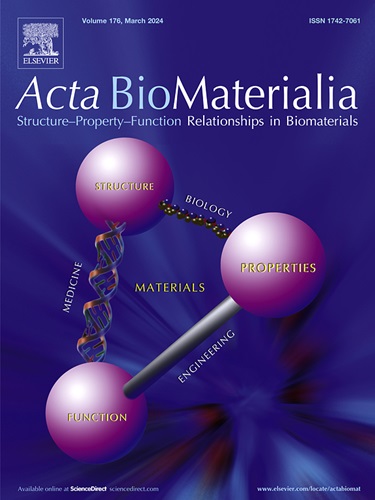An injectable and adaptable system for the sustained release of hydrogen sulfide for targeted diabetic wound therapy by improving the microenvironment of inflammation regulation and angiogenesis
IF 9.4
1区 医学
Q1 ENGINEERING, BIOMEDICAL
引用次数: 0
Abstract
The combined effects of persistent chronic inflammation, oxidative stress, microcirculation disorders, and dysregulated cellular energy metabolism often hinder the repair of diabetic skin wounds. Traditional treatment methods are typically insufficient in simultaneously addressing these complex factors, resulting in delayed wound healing and a high propensity for recurrence and chronic ulceration. This study developed an innovative strategy based on reactive oxygen species (ROS)–responsive nanoparticles loaded with an ultraviolet (UV)-light-responsive hydrogen sulfide (H2S) donor. This approach leverages the endogenous ROS present in diabetic wounds and external UV light as dual triggers to facilitate the controlled and stepwise release of H2S. The material design explicitly targets the critical challenges in diabetic wound repair, including the inhibition of chronic inflammation, oxidative stress reduction, microcirculation improvement, and support of cellular energy metabolism, thereby significantly accelerating wound healing. This adaptive release of signaling molecules effectively modulates the wound regeneration microenvironment, enhancing the repair process and offering a promising solution for diabetic skin wound management.
Statement of significance
This study developed an innovative strategy based on reactive oxygen species (ROS)–responsive nanoparticles loaded with an ultraviolet (UV)-light-responsive hydrogen sulfide (H2S) donor. This approach leverages the endogenous ROS present in diabetic wounds and external UV light as dual triggers to facilitate the controlled and stepwise release of H2S. The material design explicitly targets the critical challenges in diabetic wound repair, including the inhibition of chronic inflammation, oxidative stress reduction, microcirculation improvement, and support of cellular energy metabolism, thereby significantly accelerating wound healing. This adaptive release of signaling molecules effectively modulates the wound regeneration microenvironment, enhancing the repair process and offering a promising solution for diabetic skin wound management.

一种可注射且适应性强的系统,通过改善炎症调节和血管生成的微环境,用于靶向糖尿病伤口治疗的硫化氢缓释。
持续的慢性炎症、氧化应激、微循环障碍和细胞能量代谢失调的综合作用经常阻碍糖尿病皮肤伤口的修复。传统的治疗方法通常不足以同时解决这些复杂的因素,导致伤口愈合延迟,复发和慢性溃疡的高倾向。本研究开发了一种基于活性氧(ROS)响应纳米颗粒的创新策略,该纳米颗粒装载了紫外线(UV)光响应硫化氢(H2S)供体。该方法利用糖尿病伤口中存在的内源性ROS和外部紫外线作为双重触发因素,促进H2S的可控和逐步释放。该材料设计明确针对糖尿病伤口修复的关键挑战,包括抑制慢性炎症、减少氧化应激、改善微循环和支持细胞能量代谢,从而显著加速伤口愈合。这种信号分子的自适应释放有效地调节了伤口再生微环境,增强了修复过程,为糖尿病皮肤伤口管理提供了一个有希望的解决方案。意义声明:本研究开发了一种基于活性氧(ROS)响应纳米颗粒的创新策略,该纳米颗粒装载了紫外线(UV)光响应硫化氢(H2S)供体。该方法利用糖尿病伤口中存在的内源性ROS和外部紫外线作为双重触发因素,促进H2S的可控和逐步释放。该材料设计明确针对糖尿病伤口修复的关键挑战,包括抑制慢性炎症、减少氧化应激、改善微循环和支持细胞能量代谢,从而显著加速伤口愈合。这种信号分子的自适应释放有效地调节了伤口再生微环境,增强了修复过程,为糖尿病皮肤伤口管理提供了一个有希望的解决方案。
本文章由计算机程序翻译,如有差异,请以英文原文为准。
求助全文
约1分钟内获得全文
求助全文
来源期刊

Acta Biomaterialia
工程技术-材料科学:生物材料
CiteScore
16.80
自引率
3.10%
发文量
776
审稿时长
30 days
期刊介绍:
Acta Biomaterialia is a monthly peer-reviewed scientific journal published by Elsevier. The journal was established in January 2005. The editor-in-chief is W.R. Wagner (University of Pittsburgh). The journal covers research in biomaterials science, including the interrelationship of biomaterial structure and function from macroscale to nanoscale. Topical coverage includes biomedical and biocompatible materials.
 求助内容:
求助内容: 应助结果提醒方式:
应助结果提醒方式:


